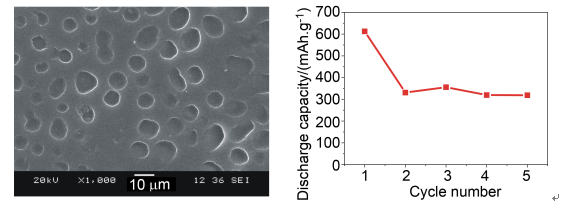| [1] Deng, C.; Shi, P.-F.; Zhang, S. Acta Chim. Sinica 2006, 64, 1031. (邓超, 史鹏飞, 张森, 化学学报, 2006, 64, 1031.) [2] (a) Zhao, X. Y.; Ma, L. Q. Int. J. Hydrogen Energy 2009, 34, 4788; (b) Liu, S.-Q.; Chen, D.-Y.; Huang, K.-L.; Zhong, X.-L. Acta Chim. Sinica 2009, 67, 513. (刘素琴, 陈东洋, 黄可龙, 仲晓铃, 化学学报, 2009, 67, 513.) [3] Zhu, Y. F.; Zhang, W. F.; Yang, C.; Li, L. Q. Int. J. Hydrogen Energy 2010, 35, 9653. [4] Yang, C. M.S. Thesis, Nanjing University of Technology, Nanjing, 2011. (杨尘, 硕士论文, 南京工业大学, 南京, 2011.) [5] Mohamad, A. A.; Mohamed, N. S.; Alias, Y.; Arof, A. K. J. Alloys Compd. 2002, 337, 208. [6] Yuan, A. B.; Zhao, J. Electrochim. Acta 2006, 51, 2454. [7] Qiao, J.-L.; Fu, J.; Lin, R.; Ma, J.-X.; Liu, J.-S. Polymer 2010, 51, 4850. [8] Yang, J.-M.; Chiang, C.-Y.; Wang, H.-Z.; Yang, C.-C. J. Membr. Sci. 2009, 341, 186. [9] Mohamad, A. A.; Arof, A. K. Ionics 2008, 14, 415. [10] (a) Yang, C.-C.; Chiu, S.-J.; Chien, W.-C.; Chiu, S.-S. J. Power Sources 2010, 195, 2212; (b) Sang, S. B.; Wu, Q. M.; Gan, Z. Electrochim. Acta 2008, 53, 5065. [11] Boudin, F.; Andrieu, X.; Jehoulet, C.; Olsen, I. I. J. Power Sources 1999, 81, 804. [12] Yang, C. C.; Yang, J. M.; Wu, C. Y. J. Power Sources 2009, 191, 669. [13] (a) Chen, Z.-Y.; Ju, Y.-L.; Zhang, W.-F.; Zhu, Y.-F.; Li, L.-Q. Mater. Rev. 2009, 23, 316. (陈忠元, 居亚兰, 张文峰, 朱云峰, 李李泉, 材料导报, 2009, 23, 316.); (b) Chen, Z.-Y.; Ju, Y.-L.; Zhang, W.-F.; Zhu, Y.-F.; Li, L.-Q. J. Funct. Mater. 2008, 39, 527. (陈忠元, 居亚兰, 张文峰, 朱云峰, 李李泉, 功能材料, 2008, 39, 527.) [14] Yang, C. C.; Chiu, S. S.; Kuo, S. C.; Liou, T. H. J. Power Sources 2011, 196, 4458. [15] Rashkov, I.; Manolova, N.; Li, S. M.; Espartero, J. L.; Vert, M. Macromolecules 1996, 29, 50. [16] (a) Li, Y.-J. M S. Thesis, Soochow University, Suzhou, 2011. (李延洁, 硕士论文, 苏州大学, 苏州, 2011); (b) Yang, Y.-X.; Yang, B.-Y.; Duan, X.-J. Silicone Fluorine Info. 2004, 9, 27. (杨元秀, 杨本意, 段先健, 有机硅氟资讯, 2004, 9, 27.); (c) Yang, Y.-X.; Yang, B.-Y.; Duan, X.-J. Silicone Fluorine Info. 2005, 11, 40. (杨元秀, 杨本意, 段先健, 有机硅氟资讯, 2005, 11, 40.); (d) Zhang, W.-H.; Fan, X.-D.; Tian, W.; Fan, W.-W.; Cheng, G.-W. Acta Chim. Sinica 2011, 69, 2047. (张卫红, 范晓东, 田威, 范伟伟, 程广文, 化学学报, 2011, 69, 2047.) [17] (a) Lue, S. J.; Mahesh, K. P. O.; Wang, W. T.; Chen, J. Y.; Yang, C. C. J. Membr. Sci. 2011, 367, 256; (b) Yang, C. C.; Li, Y. J.; Liou, T. H. Desalination 2011, 276, 366; (c) Kim, D. S.; Park, H. B.; Rhim, J. W.; Lee, W. M. J. Membr. Sci. 2004, 240, 37. [18] (a) Saunier, J.; Gorecki, W.; Alloin, F.; Sanchez, J. Y. J. Phys. Chem. B 2005, 109, 2487; (b) Kataoka, H.; Saito, Y.; Quaitarone, E.; Mustarelli, P. J. Phys. Chem. B 2000, 104, 11460. [19] Yang, C. C. Mater. Sci. Eng. B 2006, 131, 256. [20] (a) Michot, T.; Nishimoto, A.; Watanabe, M. Electrochim. Acta 2000, 45, 1347; (b) Chen, Z.-Y. M.S. Thesis, Nanjing University of Technology, Nanjing, 2009. (陈忠元, 硕士论文, 南京工业大学, 南京, 2009); (c) Suzuki, S.; Kimishima, K.; Takita, K. JP 2005082651-A, 2005 [Chem. Abstr. 2005, 20050331]. [21] Mohamad, A. A. Ionics 2005, 11, 294.[22] Zhu, Y. F.; Wang, Y. C.; Li, L. Q. Int. J. Hydrogen Energy 2008, 33, 2965. |
